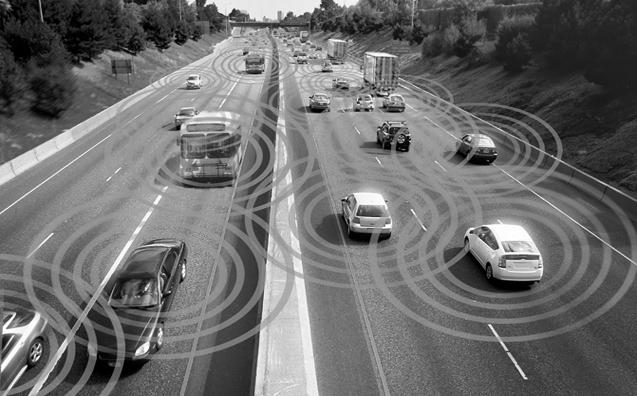New vehicle technology to reduce collisions
New automobile communication technology will allow cars to transfer data such as vehicle length, width, and mass from one to another. Experts hope that the system will allow people riding in vehicles to remain safer.
The National Highway Traffic Safety Administration (NHTSA) has decided to require newly made cars to broadcast their location, direction, and speed to avoid collisions through vehicle-to-vehicle communication technology.
Three years ago, the Department of Transportation published the original plan for the vehicle-to-vehicle communications technology, explaining what kinds of data would be transmitted.
“Data that may be exchanged includes each vehicle’s latitude, longitude, time, heading angle, speed, lateral acceleration, longitudinal acceleration, yaw rate, throttle position, brake status, steering angle, headlight status, turn signal status, vehicle length, vehicle width, vehicle mass, bumper height, and the number of occupants in the vehicle.”
Currently, vehicles contain several additional technologies that help drivers stay safe on the road. For example, some cars automatically stop to avoid collisions, or can remain at a fixed distance behind another car. Others can also avoid drifting and steer back into a lane automatically.
With the new law, vehicles would become even safer, severely reducing the number of accidents. Transportation secretary Anthony Foxx informed reporters that new innovations merited further safety mechanisms.
“A lot of innovation and safety to this point has been about protecting the occupants of a vehicle after an accident occurs, [but now] the safety advances kick in before an accident occurs,” he said.
The proposed system currently plans to provide drivers with warnings, and would not automatically take control of the vehicle. Instead, the warnings would show up either on a display screen, or perhaps through a vibrating steering wheel.
In the future, experts hope that the system will allow people riding in vehicles to remain safer and more controlled, allowing the tedious time spent in traffic to be better used working. Additionally, the new system could possibly help those with disabilities.
“We think of cars as mechanical systems, but they are actually rolling computers. These computers are changing what it means to drive,” said John Lee, a professor at the University of Washington, in a Senate Commerce Committee.
However, with the revelations from Snowden, some experts remain concerned that the new system will grant the government more control over more sectors of personal life, in this case, vehicles.
Others simply do not trust the new system, because they believe that the technology does not exist, and would be infeasible.
“I don’t think that vehicle-to-vehicle technology is really a good idea,” Venkat Sankar (9) said. “Although it might make driving safer, it seems far-fetched and I think it won’t help much until the technology is completely created.”
Foxx hopes that the law concept will start to be implemented before President Obama leaves office in 2017. He believes that eventually, the system could be expanded to herald a new generation of technology.

Vineet Kosaraju (12) is the STEM Editor for both Harker Aquila and Winged Post. He is a senior and has been part of the journalism program for the past...

Vedant Thyagaraj is the Science & Technology Editor for Harker Aquila. He is currently a senior and has been on staff for the past three years. Vedant...


















![“[Building nerf blasters] became this outlet of creativity for me that hasn't been matched by anything else. The process [of] making a build complete to your desire is such a painstakingly difficult process, but I've had to learn from [the skills needed from] soldering to proper painting. There's so many different options for everything, if you think about it, it exists. The best part is [that] if it doesn't exist, you can build it yourself," Ishaan Parate said.](https://harkeraquila.com/wp-content/uploads/2022/08/DSC_8149-900x604.jpg)




![“When I came into high school, I was ready to be a follower. But DECA was a game changer for me. It helped me overcome my fear of public speaking, and it's played such a major role in who I've become today. To be able to successfully lead a chapter of 150 students, an officer team and be one of the upperclassmen I once really admired is something I'm [really] proud of,” Anvitha Tummala ('21) said.](https://harkeraquila.com/wp-content/uploads/2021/07/Screen-Shot-2021-07-25-at-9.50.05-AM-900x594.png)







![“I think getting up in the morning and having a sense of purpose [is exciting]. I think without a certain amount of drive, life is kind of obsolete and mundane, and I think having that every single day is what makes each day unique and kind of makes life exciting,” Neymika Jain (12) said.](https://harkeraquila.com/wp-content/uploads/2017/06/Screen-Shot-2017-06-03-at-4.54.16-PM.png)








![“My slogan is ‘slow feet, don’t eat, and I’m hungry.’ You need to run fast to get where you are–you aren't going to get those championships if you aren't fast,” Angel Cervantes (12) said. “I want to do well in school on my tests and in track and win championships for my team. I live by that, [and] I can do that anywhere: in the classroom or on the field.”](https://harkeraquila.com/wp-content/uploads/2018/06/DSC5146-900x601.jpg)
![“[Volleyball has] taught me how to fall correctly, and another thing it taught is that you don’t have to be the best at something to be good at it. If you just hit the ball in a smart way, then it still scores points and you’re good at it. You could be a background player and still make a much bigger impact on the team than you would think,” Anya Gert (’20) said.](https://harkeraquila.com/wp-content/uploads/2020/06/AnnaGert_JinTuan_HoHPhotoEdited-600x900.jpeg)

![“I'm not nearly there yet, but [my confidence has] definitely been getting better since I was pretty shy and timid coming into Harker my freshman year. I know that there's a lot of people that are really confident in what they do, and I really admire them. Everyone's so driven and that has really pushed me to kind of try to find my own place in high school and be more confident,” Alyssa Huang (’20) said.](https://harkeraquila.com/wp-content/uploads/2020/06/AlyssaHuang_EmilyChen_HoHPhoto-900x749.jpeg)



